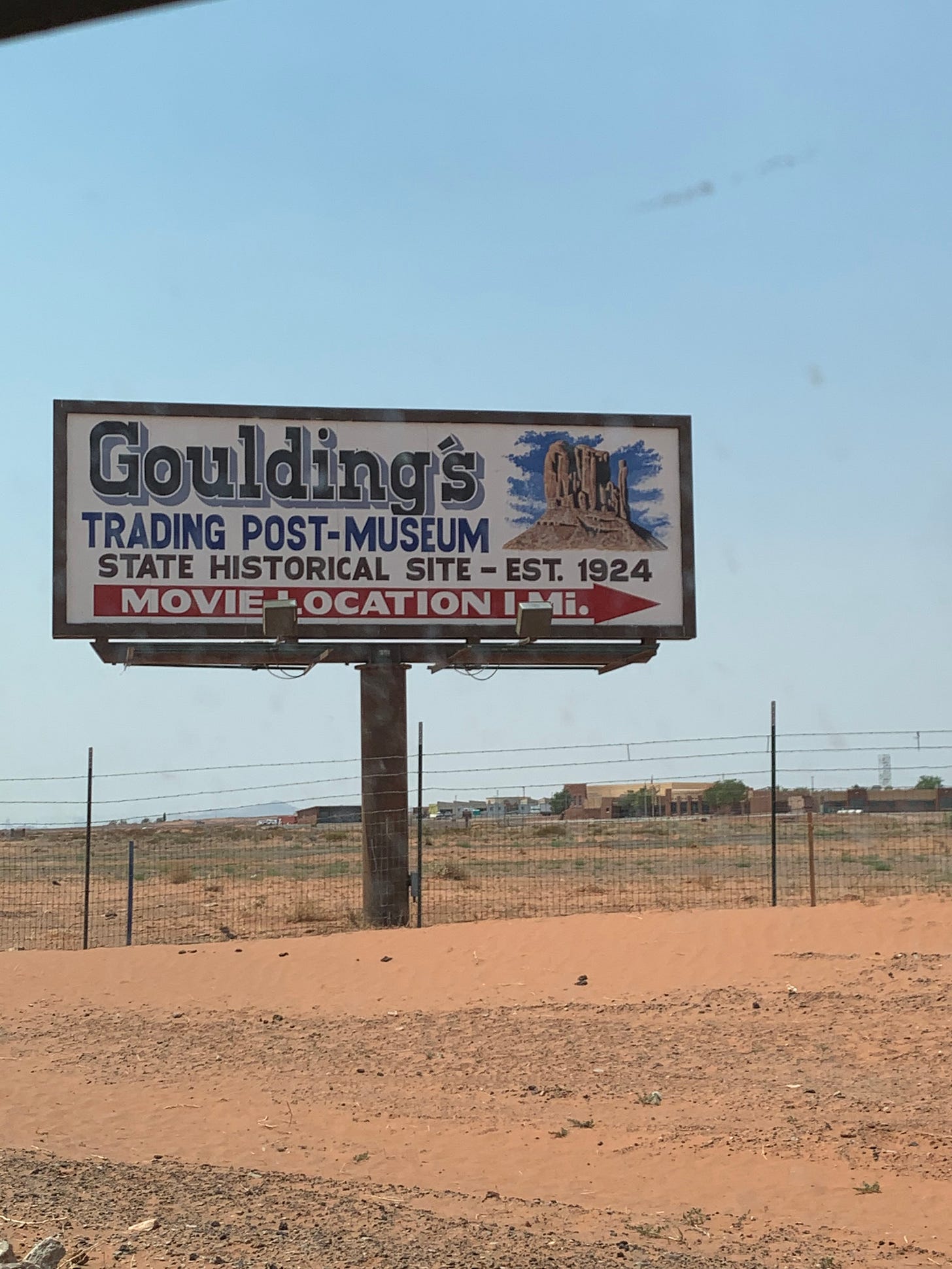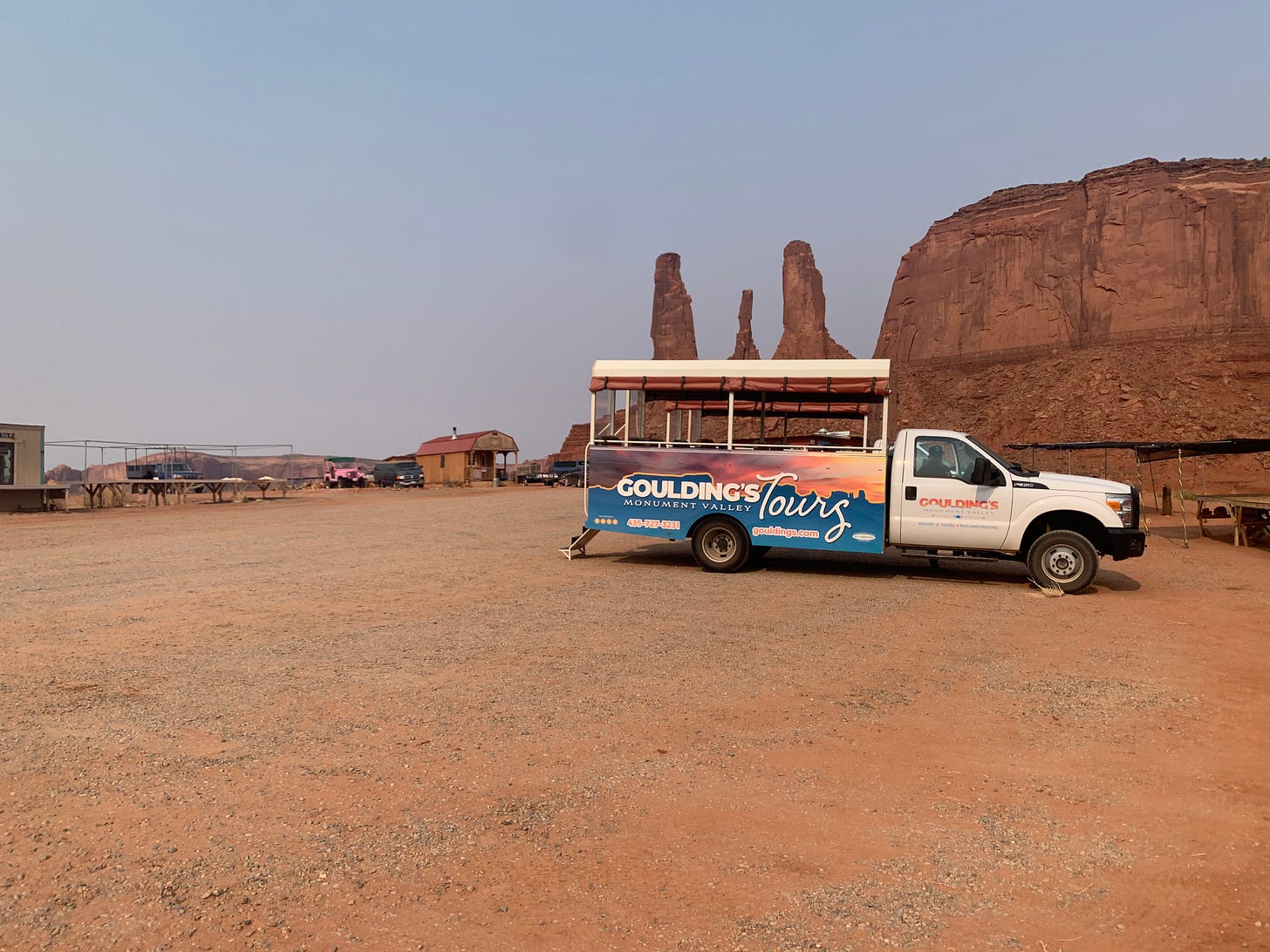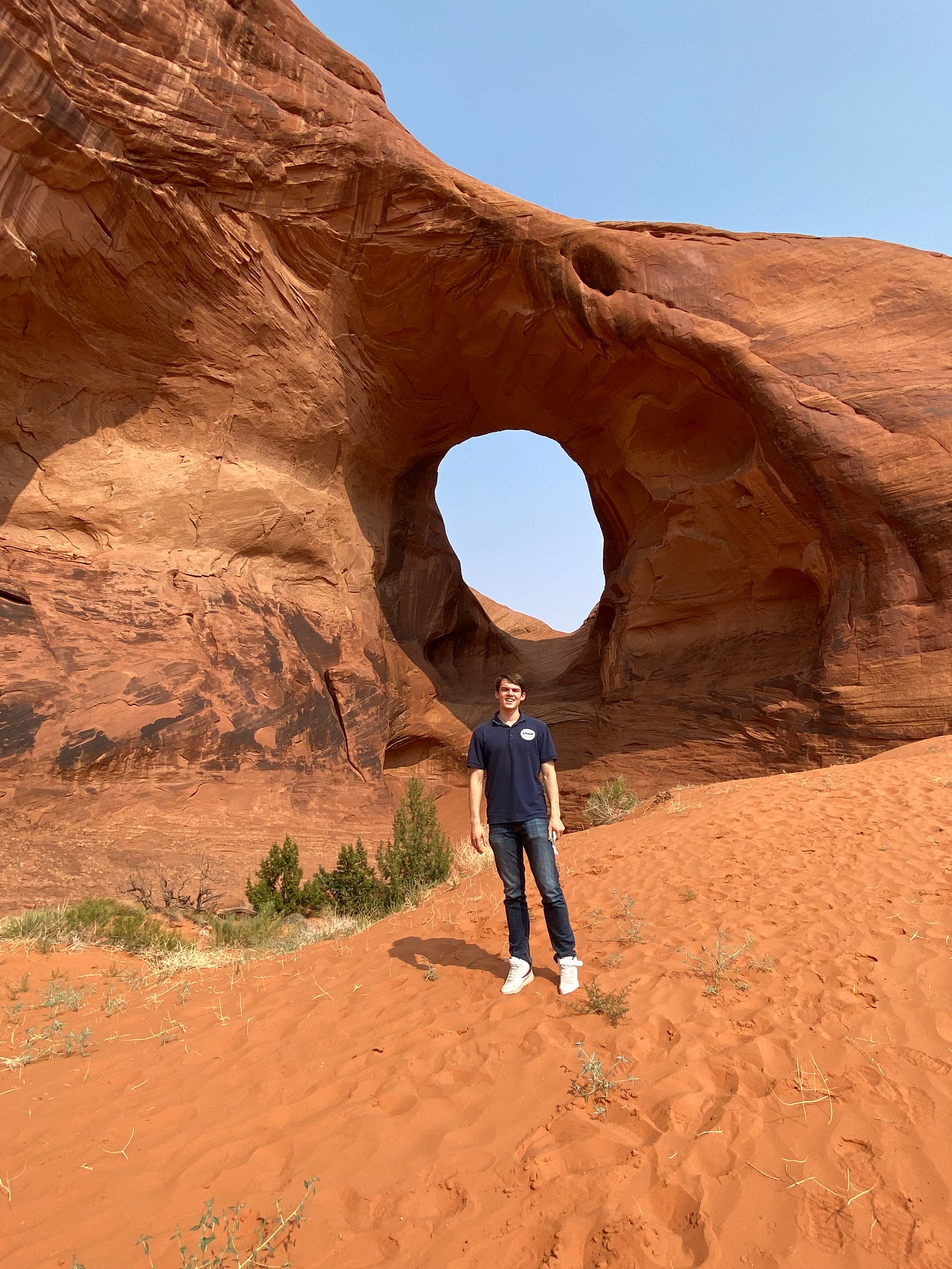Red Dust
John Ford, Cinema, and the American Iconography They Created
This edition of Print the Legend stems again from my travels this summer and reflect on Monument Valley and how American film director John Ford utilized the landscape to fuel his vision of America’s past.
My last trip in Arizona took me to Monument Valley, whose towering rock formations became iconic symbols of the American West. In popular culture, they can be recognized in the Looney Tunes Roadrunner cartoons, but most famously in John Ford westerns like Stagecoach, Fort Apache and many more. Monument Valley was Ford’s favorite shooting location and the background of the canvas on which he painted the American West.
The area is irrevocably tied to the western classics that were filmed there - and it is a heritage that the Valley embraces. The fabled Goulding’s Lodge, where Ford’s film cast and crews stayed, pays ample tribute to the era. There’s a museum, a preserved cabin used as the exterior for John Wayne’s home in She Wore a Yellow Ribbon (named somewhat jokingly as “John Wayne’s cabin” even though Wayne never slept there, and Goulding used it to store potatoes), as well as a small movie theatre that shows a John Wayne movie every night. Even the restaurant is named “Stagecoach.” In short, it is camp at its most unapologetic.
The lodge has an interesting past as a former trading post established by Harry Goulding and his wife “Mike” on Navajo land in 1928. Goulding built a strong relationship with the Navajos, a relationship that grew closer during the trying years of the Great Depression. Looking to create business opportunities for them, Goulding is commonly believed to have invited himself over to producer Walter Wanger’s offices in Los Angeles and worked his way into seeing Stagecoach’s production manager Danny Keith. When Ford saw the pictures of Monument Valley, he was immediately sold. Film historian McBride disputes this story, but regardless of how Ford discovered it, he loved the terrain and agreed to shoot Stagecoach there in 1938, with everyone housed inside the dirt floor rooms at Goulding’s lodge, the Civilian Conservation Corps barracks and another inn and trading post run by John Wetherill.1
Wary of nosy studio executives wanting to reign in his artistic decision making, Ford took any opportunity to film far away from studio influence. The making of Stagecoach especially afforded Ford the freedom to be on his own and control his vision for the story by virtue of the locations he used for filming. Ford relished filming in Monument Valley, a stunning but remote vista located on the border of Arizona and Utah. Stagecoach was the first of nine films that Ford would shoot in the locale, enshrining the Valley in the public consciousness and associating Ford’s name with the region forever after. Barry Keith Grant writes in his introduction to John Ford’s Stagecoach, that “[Ford] was happy to be at a far remove from studio interference; and by filming in a remote, isolated area he was able to establish the kind of close, almost familial working relationship with cast and crew that allowed him to develop his distinctive stock company.”2
Even more visually impressive cinematography in the area would follow in subsequent films. One of the most visually gorgeous Ford shots came in the lesser known She Wore a Yellow Ribbon. This moment saw the cavalry, led by John Wayne’s Nathan Brittles braving the elements through Monument Valley, as lightning strikes above. It was a product in some ways of the over-touted “Fordian luck,” because it was hardly planned.3 Preparing to wrap the shoot and the end of the day, Ford noticed the clouds darkening and saw the ominous approach of the thunder storm as an opportunity. He asked cinematographer Winton C. Hoch to shoot a wide of the cavalry marches to see if they could get the lightning in the shot.4 Hoch made no promises, since the light was dimming, but they gave it a go. One of the visually most striking moments in the picture, Hoch won an Academy Award for his work on the film, largely attributed to that shot.5 There has been some discussion over whether to attribute that shot to Ford or Hoch. In Peter Bogdanovich's Directed by John Ford, Ford claimed that Hoch “did it under protest and won the award,” a claim which Hoch thought diminished his contribution. Hoch claimed that it was not shot under protest and that Ford, “the old buzzard, would never sacrifice a good story for want of a few facts,” a statement ironically reminiscent of the famous line in Ford’s late-career western The Man Who Shot Liberty Valance: “when the legend becomes fact, print the legend.”6 In his memoir, actor Harry Carey Jr. wrote that after Ford suggested the shot, Hoch simply replied, “it’s awfully dark, Jack. But I’ll shoot it. I just can’t promise anything.”7 If anything, the shot is the result of their fruitful collaboration. Either way it became a poetic moment in which the characters brave the elements and the vast expanse around them.
One cannot forget, of course, that Ford was shooting this on Navajo land. Some have accused Ford of racism for the way his films perpetuate stereotypes. However, one can make a good argument about the double narratives that Ford performs in his works, which could be the topic of another blog post.8 Often neglected though is the warm relationship that Ford cultivated with the people who lived in Monument Valley. During hard economic times, he gave employment to Native Americans when opportunities were scarce. Moreover, he popularized Monument Valley and boosted tourism to the area, which is an effect that is still being felt today.9 As historian Joseph McBride notes, the Navajos were so fond of Ford that they made him a blood brother during a ceremony and named him “Natani Nez,” meaning “Tall Leader.”10 Ford was always very proud of that:
More than receiving Oscars, what counts for me is having been made a blood brother of various Indian nations. Perhaps it's my Irish atavism, my sense of reality, of the beauty of clans, in contrast to the modern world, the masses, the collective irresponsibility. Who better than an Irishman could understand the Indians, while still being stirred by the tales of the U.S. Cavalry. We were on both sides of the epic.11
One can debate at great lengths Ford’s deeper writing as far as Native Americans are concerned, especially as it relates to his later works, Fort Apache, The Searchers and even Cheyenne Autumn, the last of which was his earnest but not altogether successful attempt to address Native American grievances. Another interesting point he makes is the extent to which his Irish heritage made him feel kinship with tribes dispossessed of their land. That’s a topic for another time, however. Given their relationship, Ford went on to rely on the Navajos a great deal through the years, even employing a Navajo shaman to control the weather during the shoot. The shaman, Hosteen Tso, proved himself to the skeptical Ford when he conjured up a thunderstorm one day with a clear day and a dust storm the next, just as Ford requested. Goulding claimed that Tso “was always the first man on the payroll.”12
The hardship of the 1930s for Monument Valley remains unsurpassed in modern times, but the region is showing definite signs of stress today. Still, while Goulding’s Lodge is hardly the Ritz, that rusticity is part of its charm. Their two bedroom cottages are comfortable and the Stagecoach restaurant’s “comfort food” of Navajo tacos and hamburgers offers an authentic enough experience. However, the museum is “closed for renovations” and the DVD they showed Stagecoach on was scratched. Like many hotels, Goulding’s Lodge admits to dealing with massive staff shortages and finds it hard to compete with COVID-era unemployment benefits. The park itself is closed to tourists, except for guided tours. Our tour guide was a friendly Navajo man who had lived his entire life in the region, raising a large family there. This was his last day on the job. “They're hurting,” he said of Goulding’s Lodge. Finding tour guides during the pandemic has proved difficult. As for our friend, he said he will seek a job driving a truck in the oil industry, where jobs are more abundant.
Economic hardships aside, nothing can take away from the area's natural beauty. It takes a full three hours to drive around the park, yet one only begins to appreciate the plethora of beautiful panoramas and impressive buttes that dot the landscape. Each rock formation has a Navajo name and a more popular one. Look closely and you can see Alfred Hitchcock, Elvis and other figures immortalized into the stone. If you look even more closely, you can see historic rock drawings and etchings carved into the rock by Native peoples centuries ago. Until you return to your cottage to shower, you won’t notice how the arid environment baked red dust into your skin and clothes. You're almost sad to see it wash away, circling the drain and disappearing beneath it.
Joseph McBride, Searching for John Ford, (University Press of Mississippi, 2011), 288-289. The Wetherills inn and trading post was in Kayenta, 25 miles away from Monument Valley, so it did not have the same advantages as Goulding’s Lodge for tourism. However, McBride quotes Gary Wills that “in the John Ford mythology, the Gouldings have completely displaced the Wetherills, who were there before them and first brought film companies to the era.” Wills cites Wanger documents that suggest the Weatherills might have facilitated the Gouldings relationship with the studio. During Stagecoach, according to McBride, Ford and other higher-ups actually stayed at the Wetherills. This is another “print the legend” moment. See McBride, 289.
Quoted in Charles Maland, ‘“Powered by a Ford?’ Dudley Nichols, Authorship and Cultural Ethos in Stagecoach.” John Ford's Stagecoach (Cambridge Film Handbooks) (Kindle Locations 136-138). Kindle Edition.
Actress Maureen O’Hara dispels notions about “Fordian luck” in her tell-all memoir, ‘Tis Herself.
Harry Carey, Jr.. Company of Heroes., (Taylor Trade, 2013), 67
Harry Carey 67, 68
McBride, 460.
Carey Jr., 67
See Tag Gallagher’s John Ford: The Man and His Films.
Navajos earned $3 a day, according to McBride, which was less than industry standard, but given that “annual per capita income for members of the tribe was $82 compared to $579,” it was not to their detriment to accept the labor. See McBride, 295.
McBride, 292.
McBride, 291.
McBride 293.




